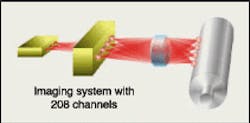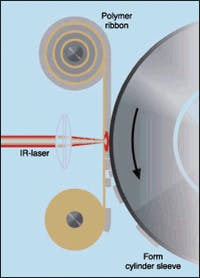Diode lasers shorten print runs for commercial color printing
If we look into the blue sky, we see a perfect contiguous image, despite the grainy structure of our retina. It is our brain that composes the image we "see" from the photonic information received in parallel via millions of individual pixels. The contiguous impression still remains even if the object viewed is composed of pixels, as long as those pixels are sufficiently small and closely spaced. This fact is already made use of in black-and-white photography. More importantly, almost perfect spectral color viewing is achieved by recomposing information that is split into only a few "color channels."
As a result, in color printing, closely spaced pixels in three colors—cyan, magenta, and yellow (CMY)—plus black can be used to compose a visually perfect picture. Pixels are to pictures what letters are to words, anything can be generated, and today it can be done entirely by computer. This latter fact gave rise to the biggest revolution in printing industry since the invention of book printing—desk-top publishing. It is possible because of sophisticated PCs, the accompanying software, and small office color printers. Laser-based small office printers have turned out to be an important application of laser diodes.
Lasers also made fast progress entering the large-scale printing industry. Production of widely circulated newspapers, magazines, and books is usually performed by offset printing, for which printing plates are made by imaging large transparency films—exposed on laser-image setters—to the printing plates that are then mounted on the press cylinders. As an improvement to this approach, printing plates were directly written by laser (computer-to-plate) but the plates still had to be mounted and adjusted on the press cylinders. These manual handling steps take time and make up a considerable part of the operating costs, which are high enough that long print runs are necessary to keep a single copy of the resulting printed piece affordable.
Printing on demand
The printing market, however, has been looking for economical production of shorter or low print runs with "printing on demand" being the ultimate goal. To meet these requirements, MAN Roland Druckmaschinen AG (Augsburg, Germany), explored direct writing onto a printing cylinder with diode lasers (computer-to-press) and introduced such a system at last year's DRUPA 2000 (Dusseldorf, Germany; see Laser Focus World August 2000, p. 38). Computer-to-press does not use plates. Instead, digital image data is directly transferred to the printing cylinder by an array of laser diodes using parallel data flow. After printing, the image is erased so the printing cylinder can be re-imaged.
Direct writing onto the metal printing cylinder means altering the adhesive properties of the surface. Offset printing relies on the adhesion (or not) of mineral-oil-based colored ink to the surface. The unimaged (deimaged) surface is water accepting (hydrophilic). Imaging is performed pixel by pixel. In the MAN Roland system this process is achieved by laser-induced thermal transfer of an appropriate polymer from a ribbon onto the cylinder surface (see Fig. 1). After conditioning for ink and water receptivity, the transferred polymer pixels make up the ink-accepting areas. The ribbon is comparable in width to standard videotape and is housed in a cartridge. It consists of a polymer carrier and the transfer polymer layer, which is in close contact to the printing cylinder. Transfer is induced by local heating caused by absorption of laser radiation, followed by thermal fixing done with inductive heating of the metallic printing cylinder up to 150±C.
The tape allows parallel writing of 208 channels using an imaging system from CreoScitex (Burnaby, British Columbia, Canada; see Fig. 2). The writing is performed simultaneously on all eight print units, four (CMY and black) for the front and four for the back. An exposure head on each printing cylinder is moved across the width of the cylinder to write the full image. For the 208 channels, an exposure head is used that provides an output of 18 W and is equipped with a light-valve to modulate each channel (on-off). Wavelength is in the range of 820 to 840 nm. An autofocus system controls the spot size. A resolution of 3200 dpi (8-µm spot width) is attainable. The transfer material requires about 400 mJ of radiation energy per square centimeter. Because the actual printing relies on ordinary offset technology, only standard paper and standard ink are required. Up to 30,000 copies can be printed before re-imaging becomes necessary.The time required to image the cylinder is only about two minutes, and a change of jobs takes only about ten minutes. The polymer is chemically removed from the cylinder using an environmentally compatible liquid with a fleece as an absorber. Up to at least 200 refreshing and changeover cycles are possible for one cylinder.
This novel technology opens the gate to more economical short-run color printing. It will lower the threshold for edits to color print products, an important improvement for editing such items as manuals and updating them.
About the Author
Uwe Brinkmann
Contributing Editor, Germany
Uwe Brinkmann was Contributing Editor, Germany, for Laser Focus World.

